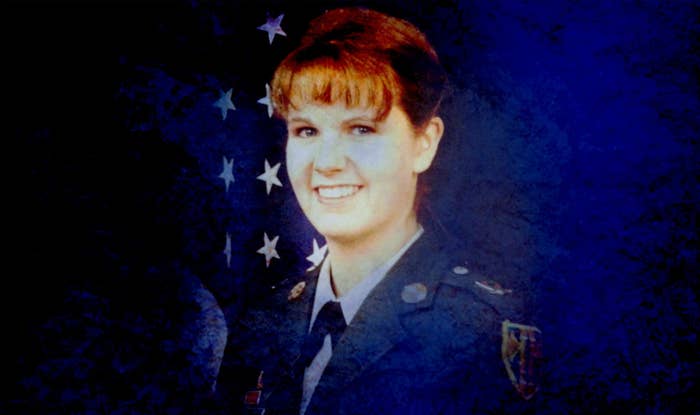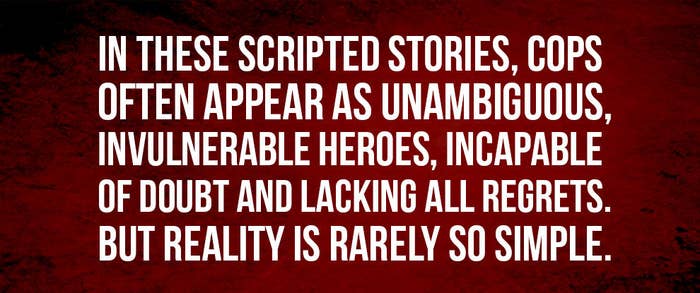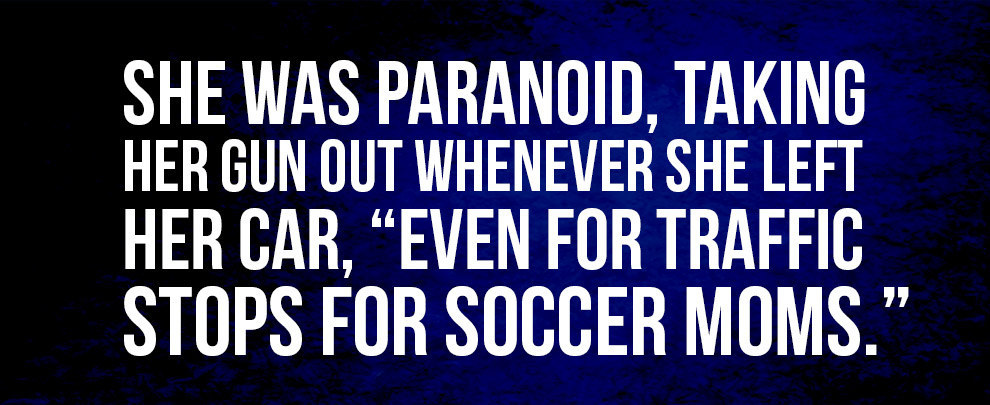
FOXBOROUGH, Massachusetts — On the balmy night of June 23, 2004, Officer Jackie Person drove to a narrow street surrounded by woods to deal with a lovers' quarrel. She parked her cruiser near the end of a long driveway and walked toward a modest duplex, holding her flashlight near her face.
Suddenly, she told BuzzFeed News, she heard a gurgling sound from behind a car in the driveway. She turned around to face the noise and saw a large man with drunken eyes and a half-open mouth staggering toward her. She shone her flashlight on him and saw a 12-inch knife in his right hand.
"I'm with the police!" Person yelled. "Drop that knife right now!"
The man disobeyed and kept moving toward Person. She started walking backward, toward the street. She felt her right hand instinctively reach for her pepper spray — and then move to her holster. She drew her Glock .45 and kept backing up, yelling for the man to stop.
Then Person felt her ankle hit something. She would later realize it was the edge of the sidewalk on the other side of the street, but in the darkness it felt as if she had hit a wall. She felt trapped; the man kept coming closer.
"The last thing I said to him was that I had a gun and was going to shoot," Person told BuzzFeed News. "Then I fired a single round."
The man collapsed face down, falling "so hard he bounced right back up." His blood began to pool on the pavement. He got so close to Person that his head came to rest inches from her feet.
Later, Person would learn that the man she killed was Thomas Shea. She would learn that he had been going through tough times and had called the police after getting in a shouting match with his ex-wife. She would learn that her bullet entered his mouth and exited through the back of his head without breaking any teeth. She would also learn that Shea's teenage son watched the whole thing from his bedroom window.
And she would have to learn to live with that knowledge.
Police management and unions actively discourage officers from discussing shootings with reporters, following the logic that any attention is bound to be negative. On top of that, the machismo that permeates the culture of many law-enforcement agencies stigmatizes any admission of pain, guilt, or mental illness.
The result is that the national debate on the use and abuse of force by law-enforcement agents often includes pronouncements by police chiefs and police unions, but generally lacks the voices of officers themselves. When cops involved in shootings do speak, they often present varnished accounts that have been approved by their bosses. In these scripted stories, cops often appear as unambiguous, invulnerable heroes, incapable of doubt and lacking all regrets.
But reality is rarely so simple.
Unlike the shootings of Michael Brown and countless other unarmed black men, the Foxborough incident was not controversial. Officials and even the family of the deceased agreed at the time that Person had no choice but to shoot Shea — who, like her, was white.
Still, the memory of the incident weighs on Person to this day. Her story, which she was only able to share with BuzzFeed News because she retired several years ago and is no longer bound by department regulations, shows that reducing police-involved shootings would help not only victims, but also cops.

The path that led Person to her meeting with Shea began when she was 6 years old, when she saw an episode of CHiPs.
"Nobody becomes a cop because they want to kill someone," she said. "I saw these guys in such awesome uniforms and I decided I wanted to be like them."
Person, who grew up in Foxborough, joined the town's police department in 1996, after a stint in the U.S. Army. She started out as a part-time dispatcher, but moved to a full-time patrol position shortly after she got married to a state trooper named Shawn Cayer. Since she was a rookie — "and the only girl in the department" — she was relegated to the graveyard shift.
The position proved demanding. Person was constantly sleep deprived and stressed by work, she said, and on top of that had to take care of her six children.
"I would get home in the morning after work and then do the laundry, and the cooking, and all the horsecrap you have to do when you are married," she said.
Over the years, Person became acquainted with the rhythms of tragedy in a small American town of some 17,000 people. At the time, the Foxborough police only had three or four officers on duty for the midnight shift, Department Chief Edward O'Leary told BuzzFeed News. This meant that each cop had to deal with many traumatic calls.
"Each night you may potentially run into some type of incident, whether it's a fatal crash, some kind of physically demanding arrest, or a suicide, whether it is by hanging, shooting, or overdose," O'Leary told BuzzFeed News.
"It's not like we are policing strangers," he went on. "We hire people who have grown up here, who know the community. Because of that close connection, these kind of events have a greater impact."
Person named countless incidents that stuck with her. Once, a woman called to say her husband was bleeding in his car and she couldn't wake him up. Person arrived and discovered the man had slit his own throat.
Another time, she was called to respond to an accident in which two 15-year-old boys crashed a car into a tree. Person had to remove one of the kids from the front seat.
"He looked like a laundry basket with all the clothes spilling out," Person said. "I could hear his death rattle. I was relating to it as a mother. It got me really emotional."
Later that day, Person went to the boy's house to inform his mother of what had happened.
"She screamed," Person said. "I don't know if you've ever heard a mother scream after she finds out her child is dead. I went home and cried and cried and cried."
But the most difficult calls for Person were the ones involving domestic violence. Her relationship with her husband, she said, had become abusive shortly after their marriage.
"Here I was, a police officer who would arrest people who beat their wives, and then go home to an abusive husband," she said. "It was mostly emotional abuse — there wasn't a lot of physical violence, but there were incidents. I was injured."
(The kind of abuse described by Person is common. A study by the nonprofit National Center for Women and Policing found that at least 40% of police families go through some form of domestic violence. The rate is four times higher than the general population.)
Cayer did not respond to voicemails seeking comment. He also did not respond to certified letter detailing the contents of this article.

Thomas Shea's life had been falling apart for some time before he died. A former Marine who worked as a private investigator, Shea had gone through a messy divorce and had developed a drinking problem, his brother told the Boston Globe at the time of his death.
(Shea's brother and ex-wife did not respond to numerous voicemails. Shea's ex-wife also did not respond to emails nor to a certified letter.)
On the night of the shooting, Shea was temporarily staying with his ex-wife, but they started arguing. He stormed out, telling his family they "would never see him again," the Boston Globe reported. He called the police from the driveway, then hid behind a car with a knife.
Person arrived five minutes later. She had not slept much. She was stressed. But when she saw Shea, the world became simple.
"I had to decide whether or not I felt threatened," she said. "That's a very personal decision. Everyone's perspective of danger is different. There were officers who asked me why I waited so long to shoot him. I had to decide whether I was scared or not, and I decided I was."
After the shooting, Person called an ambulance, then her supervisor. The sergeant arrived first. He grabbed Person by the shoulders and shook her, screaming, "What did you do?" over and over.
Neighbors came out of their houses. Person said she remembers kicking a tree and sitting down on the sidewalk, mumbling, "What just happened?" to herself.
"The births of my children, my marriage — everything was coming back," she said. "It was almost as if I had died too."
The rest of the night was a whirlwind. There was a trip to the hospital, a visit from her union, and a statement to her lawyer. Person cried all night. Everybody was doing their best to help, but nobody had dealt with a similar situation. According to Chief O'Leary, Foxborough had not witnessed an officer-involved shooting since the 1930s.
When she finally went home, Person's children were upset she had not bought milk from the store, like she had promised she would.
The Norfolk District Attorney sent investigators to go over the events of the shooting. They cleared Person of all wrongdoing — but her inner trial had just begun.

Person took two months off and then went back to work, but found it difficult to perform her duties. She was paranoid, taking her gun out whenever she left her car, "even for traffic stops for soccer moms."
Her troubles extended beyond work. She had trouble sleeping, and when she managed to close her eyes, she had nightmares. She saw Shea coming at her, but her gun would not work. Worried that someone or something might attack her in the dark, she began sleeping with the light on.
To deal with the insomnia, Person took anxiety pills — and when the pills didn't do it, she started supplementing them with alcohol.
"I used to be a four-times-a-year kind of girl," she said of her drinking. "Suddenly I was drinking wine every night, just to go to bed."
Overwhelmed, Person asked for more time off from the department in October 2004. Shortly afterward, she was diagnosed with post-traumatic stress disorder, or PTSD. The high incidence of the disorder among returning military veterans has been well-reported, but several studies show that police officers also suffer from the disorder at alarming rates. One researcher found that up to 46% of cops who are involved in shootings develop PTSD.
Later that year, Person started attending counseling once a week. She talked extensively about the shooting, but began to realize that her problems did not begin or end with what happened that night. She told her therapist about all the death she had witnessed — the car crashes, the suicides.
Slowly, she began to come to terms. She curtailed her drinking. She started sleeping with the lights off. The nightmares became less frequent. By 2007, three years after the incident, she started feeling like herself. In 2009, she was granted retirement from the police department, which included a pension.
But there was still an aspect of her life that remained unresolved. Her marriage with Cayer, she said, was still abusive. In 2010, she asked him for a divorce. He agreed. Their divorce was finalized in 2011.
On a recent winter evening, with Foxborough buried under two feet of snow, Person drove back to the street where she killed a man 10 years ago. She parked her family-size SUV not far from where she left her cruiser that night and turned off the engine. She sighed. Did she feel anything?
"No," she said, looking at the little duplex, surrounded by leafless trees and starless sky. "I just wish I could get the movie to stop playing in my head."
Then Person drove home to make dinner for her children.
